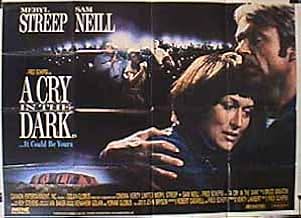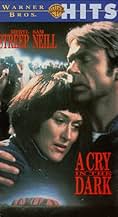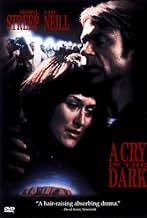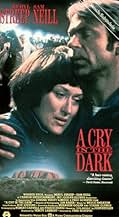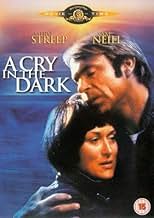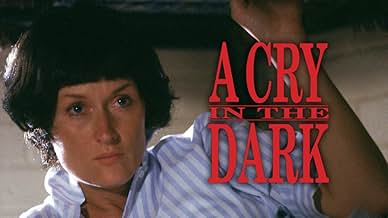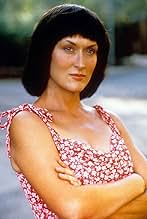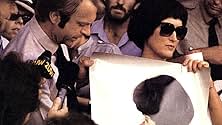A mother whose child was killed in a dingo attack in the Australian Outback fights to prove her innocence when she is accused of murder.A mother whose child was killed in a dingo attack in the Australian Outback fights to prove her innocence when she is accused of murder.A mother whose child was killed in a dingo attack in the Australian Outback fights to prove her innocence when she is accused of murder.
- Director
- Writers
- Stars
- Nominated for 1 Oscar
- 8 wins & 13 nominations total
Charles 'Bud' Tingwell
- Justice Muirhead
- (as Charles Tingwell)
- Director
- Writers
- All cast & crew
- Production, box office & more at IMDbPro
Featured reviews
Meryl Streep is such a genius. Well, at least as an actress. I know she's been made fun of for doing a lot of roles with accents, but she nails the accent every time. Her performance as Lindy Chamberlain was inspiring. Mrs. Chamberlain, as portrayed here, was not particularly likable, nor all that smart. But that just makes Streep's work all the more remarkable. I think she is worth all 10 or so of her Oscar nominations. About the film, well, there were a couple of interesting things. I don't know much about Australia, but the theme of religious bigotry among the general public played a big part in the story. I had largely missed this when I first saw the film some years ago, but it came through loud and clear yesterday. And it seems the Australian press is just as accomplished at misery-inducing pursuit and overkill as their American colleagues. A pretty good film. A bit different. Grade: B
Common sense tells us that "seeing is believing." Experience tells us that, when motivation is strong enough, it's the other way around -- "believing is seeing." Under pressure from the press and from public opinion, criminalists see blood where there is no blood. Forensic pathologists who have never see a dingo claim an absence of dingo teeth marks. Investigators see an arterial blood spray where there is nothing but a sound-deadening compound.
The case took place at a time when another of those episodes of collective hysteria was sweeping the English-speaking world. Satanic worshippers lurked in the most unlikely place and preschools were filled with pedophiles. Smokers endangered our health by subjecting us to whiffs of the burning weed. We seem to need an expression for our collective hatred. There's even evidence from gerontological studies that angry people tend to outlive more pacific individuals -- an effect the authors attributed to "the necessary enemy." Maybe now, after the resurgence of Islamic fundamentalism, we'll have more palpable enemies than will o' the wisps.
The Chamberlains were caught up in that wave of collective hatred. The case must have been a dramatic one -- wild dog eats baby! One can imagine the headlines, the earnest discussions, the fixed conclusions based on presumptions. Lindy Chamberlain certainly did nothing to discourage the calumny heaped upon her. She wasn't very good at playing the victim, in contrast to, say, the Menendez brothers who slaughtered their parents, then wept on the stand while describing how abused they were, and wound up with a mistrial. And not nearly as good as Susan Smith, the woman in the unlikely town of Union, South Carolina, who drowned her two children and sobbed openly on TV while begging the mythical black kidnapper not to harm them.
Well, after all, occupying the role of victim is an acquired skill and some have acquired less of it than others. (Mersault, in Camus' "The Stranger.") Lindy Chamberlain, as expertly played here my Meryl Streep, a phenomenally talented technical actress, is not a likable person. She matter-of-factly whines on, complaining about things in a sing-song voice, punctuated by occasional outbursts of anger. She needed some coaching from the Menendez' on how to engage the jury's sympathy. And she LOOKS wrong too. She should be small and vulnerable, instead of lumpy. And she seems to have gone out of her way to look ill-groomed. Streep, properly glamorized, is a beautiful and intelligent-looking woman. As Lindy Chamberlain her eyebrows are plucked and then painted back in as mere smudges by the makeup department. Her black hair (which should have been blonde) was probably meant to be in a style called page boy (is that right?) but comes out looking more like a Nazi helmet. Streep must have put on weight for the role. Her arms and breasts are flabby and her neck seems the size of a telephone pole, reducing her lips to a tiny pink orifice in the middle of the vast featureless plane of her face. She's as unsympathetic as all get out and human nature being what it is, people are likely to get confused about the difference between being dislikable and being guilty of murder.
Sam Neill is far more sympathetic a character but, where Streep is arrogant, he's sensitive, muddled, and weak. He's completely discombobulated by the prosecution's series of questions: "Did she say she saw anything in the dingo's mouth? Did she say she didn't see anything in the dingo's mouth? Did she tell you she saw NOTHING in the dingo's mouth?" Confused, he answers that, yes, she told him she saw the dingo come out with the baby in her mouth.
Reminds me of an interrogation from "Catch-22", something like this. Superior officer to subordinate: "When did you say we were a bunch of fools?" Subordinate: "I never said you were fools." Superior: "Now you're telling me when you DIDN'T say it. I'm asking you when you DID say we were a bunch of fools." Subordinate: "I ALWAYS never say you were a bunch of fools."
It's a fast-paced movie. If there were any dissolves I missed them. The story comes to us in pointed scenes of the Chamberlains together, intercut with snippets of public reaction to the spectacle. But the movie, for all the tragedy inherent in the story, isn't gripping. It not only has no hero or heroine, there's no one who's particularly likable. Neill suffers in silence and Streep has almost done too good a job alienating us from her character and her anguish. But overall, whatever it lacks in emotional impact it more than makes up for in its instructive quality. And of course our sympathies are with the real-life Chamberlains who were put through an immeasurable ordeal. The press and the gossipy, half-hysterical public may be easy targets, but they're very real threats to our collective common sense.
The case took place at a time when another of those episodes of collective hysteria was sweeping the English-speaking world. Satanic worshippers lurked in the most unlikely place and preschools were filled with pedophiles. Smokers endangered our health by subjecting us to whiffs of the burning weed. We seem to need an expression for our collective hatred. There's even evidence from gerontological studies that angry people tend to outlive more pacific individuals -- an effect the authors attributed to "the necessary enemy." Maybe now, after the resurgence of Islamic fundamentalism, we'll have more palpable enemies than will o' the wisps.
The Chamberlains were caught up in that wave of collective hatred. The case must have been a dramatic one -- wild dog eats baby! One can imagine the headlines, the earnest discussions, the fixed conclusions based on presumptions. Lindy Chamberlain certainly did nothing to discourage the calumny heaped upon her. She wasn't very good at playing the victim, in contrast to, say, the Menendez brothers who slaughtered their parents, then wept on the stand while describing how abused they were, and wound up with a mistrial. And not nearly as good as Susan Smith, the woman in the unlikely town of Union, South Carolina, who drowned her two children and sobbed openly on TV while begging the mythical black kidnapper not to harm them.
Well, after all, occupying the role of victim is an acquired skill and some have acquired less of it than others. (Mersault, in Camus' "The Stranger.") Lindy Chamberlain, as expertly played here my Meryl Streep, a phenomenally talented technical actress, is not a likable person. She matter-of-factly whines on, complaining about things in a sing-song voice, punctuated by occasional outbursts of anger. She needed some coaching from the Menendez' on how to engage the jury's sympathy. And she LOOKS wrong too. She should be small and vulnerable, instead of lumpy. And she seems to have gone out of her way to look ill-groomed. Streep, properly glamorized, is a beautiful and intelligent-looking woman. As Lindy Chamberlain her eyebrows are plucked and then painted back in as mere smudges by the makeup department. Her black hair (which should have been blonde) was probably meant to be in a style called page boy (is that right?) but comes out looking more like a Nazi helmet. Streep must have put on weight for the role. Her arms and breasts are flabby and her neck seems the size of a telephone pole, reducing her lips to a tiny pink orifice in the middle of the vast featureless plane of her face. She's as unsympathetic as all get out and human nature being what it is, people are likely to get confused about the difference between being dislikable and being guilty of murder.
Sam Neill is far more sympathetic a character but, where Streep is arrogant, he's sensitive, muddled, and weak. He's completely discombobulated by the prosecution's series of questions: "Did she say she saw anything in the dingo's mouth? Did she say she didn't see anything in the dingo's mouth? Did she tell you she saw NOTHING in the dingo's mouth?" Confused, he answers that, yes, she told him she saw the dingo come out with the baby in her mouth.
Reminds me of an interrogation from "Catch-22", something like this. Superior officer to subordinate: "When did you say we were a bunch of fools?" Subordinate: "I never said you were fools." Superior: "Now you're telling me when you DIDN'T say it. I'm asking you when you DID say we were a bunch of fools." Subordinate: "I ALWAYS never say you were a bunch of fools."
It's a fast-paced movie. If there were any dissolves I missed them. The story comes to us in pointed scenes of the Chamberlains together, intercut with snippets of public reaction to the spectacle. But the movie, for all the tragedy inherent in the story, isn't gripping. It not only has no hero or heroine, there's no one who's particularly likable. Neill suffers in silence and Streep has almost done too good a job alienating us from her character and her anguish. But overall, whatever it lacks in emotional impact it more than makes up for in its instructive quality. And of course our sympathies are with the real-life Chamberlains who were put through an immeasurable ordeal. The press and the gossipy, half-hysterical public may be easy targets, but they're very real threats to our collective common sense.
Some movies seem to be made before we are ready for them. As I watched this film, made in 1988, in 1999, I thought I was watching the O.J. Simpson debacle (although I have very different opinions about the innocence of the individuals in each situation).
The Australian news media, if this movie is to be believed, devoured the case of a possible infanticide and truth was left as an afterthought. It was scary to see the scenes of invasive, swarming media hordes, ridiculous accounts of half-truths and lies and debates over the supposed merits of the case by persons at all levels of society.
Equally appalling is the media's depiction as indifferent and uncomprehending of the technical information in the case. I do wish more was made of the issue of religious prejudice in the case (the accused are Seven-Day Adventists).
Today these circuses have become common but that makes the lesson only more important.
Streep is excellent as usual, and this is the best I've ever seen Sam Neill. The Aussie accents get a bit thick at times but not incomprehensible.
The Australian news media, if this movie is to be believed, devoured the case of a possible infanticide and truth was left as an afterthought. It was scary to see the scenes of invasive, swarming media hordes, ridiculous accounts of half-truths and lies and debates over the supposed merits of the case by persons at all levels of society.
Equally appalling is the media's depiction as indifferent and uncomprehending of the technical information in the case. I do wish more was made of the issue of religious prejudice in the case (the accused are Seven-Day Adventists).
Today these circuses have become common but that makes the lesson only more important.
Streep is excellent as usual, and this is the best I've ever seen Sam Neill. The Aussie accents get a bit thick at times but not incomprehensible.
Excellent true-life drama from director and co-writer Fred Schepisi, adapting John Bryson's book "Evil Angels" with Robert Caswell, details the 1980 case of a nine-week-old baby allegedly carried off by a wild dingo at a camping site at Ayers Rock in the Northern territory of central Australia. The infant's parents, the Chamberlains, a Seventh-day Adventist pastor and his wife, cooperate with the authorities and give all the necessary print and television interviews--they, in fact, do everything asked of them--but their misunderstood religion coupled with Lindy Chamberlain's stoic demeanor turns the tide of public opinion against them, from sympathetic to vengeful. Everything about this private couple soon becomes suspect under the microscope, including the meaning of their child's name, Azaria, to the discovery of baby clothes in the Outback that had cuts on them but no teeth marks. Meryl Streep's riveting performance as Lindy is quite remarkable. This is a woman who hides the sadness in her eyes behind sunglasses, who has grieved until reaching a kind of jaded resolve--she quickly becomes as suspicious of the badgering legal and media figures as the public is of her. Schepisi's docudrama-styled take on the tragedy sweeping Australia is marvelously rendered, and all the performers, especially Sam Neill as husband Michael, do powerful work. A classy production from (surprise!) Golan-Globus and Cannon Entertainment resulted in a much-deserved Oscar nomination for Streep, affecting a realistic Aussie accent (no surprise there). *** from ****
This is an extremely-powerful based-on-a-true story film that can be infuriating to watch. I say that because how brutal a hounding press can be to people, in this case an innocent Australian couple charged with killing their baby.
Meryl Streep received a lot of recognition for her performance when this film came out but I thought Sam Neill was just as good. Let's just say they both were excellent but the role was little harder for Streep because she had to learn an Australian accent. (She learned it so well I had trouble understanding her in parts.)
Without giving anything away, all I can say is this movie will wear you out emotionally.
Meryl Streep received a lot of recognition for her performance when this film came out but I thought Sam Neill was just as good. Let's just say they both were excellent but the role was little harder for Streep because she had to learn an Australian accent. (She learned it so well I had trouble understanding her in parts.)
Without giving anything away, all I can say is this movie will wear you out emotionally.
Did you know
- Trivia(June 2008) Ranked #9 on the American Film Institute's list of the 10 greatest films in the genre "Courtroom Drama".
- GoofsIn the end credits, the movie's copyright year is 1988. In Roman numerals, it would be MCMLXXXVIII. Instead, the year is MCMLXXXIII, 1983.
There may be some version with this error, but the theatrical version did have the correct "MCMLXXXVIII".
- How long is A Cry in the Dark?Powered by Alexa
Details
- Release date
- Countries of origin
- Official site
- Language
- Also known as
- Un llanto en la oscuridad
- Filming locations
- Production companies
- See more company credits at IMDbPro
Box office
- Budget
- $15,000,000 (estimated)
- Gross US & Canada
- $6,908,797
- Opening weekend US & Canada
- $1,561,793
- Nov 13, 1988
- Gross worldwide
- $6,908,797
- Runtime
- 2h(120 min)
- Color
- Sound mix
- Aspect ratio
- 2.39 : 1
Contribute to this page
Suggest an edit or add missing content



